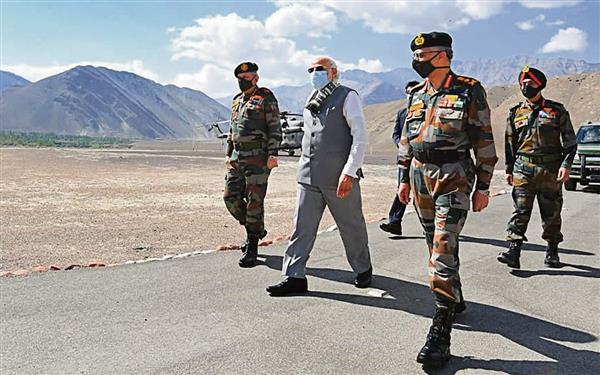- Frozen conflict in Ladakh

New rules- PM Modis tough speech has helped to shift the locus of Indian narrative from time past to


M K Bhadrakumar--Former Ambassador
India must not predicate defence on assumptions that are delusional
The risk of renewed military conflagration in eastern Ladakh receded last week. After the commanders’ conference, although the standoff would be continuing and disengagement of frontline troops might be a long haul, positive progress has been made to reduce tensions through close communication. Although mistrust remains, both sides realise the need to disengage.
It was in this backdrop that PM Modi undertook his visit to Leh on Friday. Modi has held a steady hand so far. However, for the first time, he resorted to tough rhetoric. How far this was prompted by the withering domestic criticism of his alleged failure to resist Chinese ‘aggression’ we do not know. The rhetorical speech would have boosted the morale of the troops.
The Chinese foreign ministry spokesman has since warned India against making any ‘strategic miscalculation with regard to China’. It is an unusually strong formulation. The spokesman also separately referred to ‘irresponsible remarks that are detrimental to China-India relations’ being made by politicians in India, and he went on to say that ‘China will take all necessary measures to safeguard the legitimate rights of Chinese businesses’. There is no ‘softening’ of the Chinese stance.
All in all, therefore, Modi’s tough speech helped to shift the locus of Indian narrative from time past to time future. Modi has burnished his image as a ‘strong’ leader. But then, he raised high expectations too, and fulfilling them may be difficult and risky. The military balance is such that proactive Indian actions can be almost certainly ruled out. Having said that, coercive moves may happen. The Chinese spokesman’s remarks suggest that they could be anticipating coercive moves, triggering ‘incidents’. Some degree of back-to-back collusion between China and Pakistan is also to be anticipated in such a context, as the build-up of Pakistani reserves in Gilgit-Baltistan suggests.
The bottom line is that while war remains a remote possibility, beneath that threshold, the standoff may still become ‘kinetic’, while more military talks are unlikely to achieve a restoration of ‘status quo ante’. A denouement becomes possible only at the political level. A November timeline is to be expected. During the G20 summit in Riyadh (November 21-22), the two leaders may meet. Again, China is a stakeholder in the US presidential election (November 3). The harsh winter conditions in Ladakh by November will also impose a standstill — a ‘frozen conflict’ — which is to China’s advantage.
The upshot of PM’s tough messaging is that he created political space. What complicates matters is that India is virtually alone in this enterprise. A vast majority of countries think that a foreign policy based on opposing China is hardly suited to addressing the global challenges that shape today’s world such as climate change, the post-pandemic recovery and so on.
There is a misconception among Indian analysts that the US might intimidate China to ease the pressure on India. That is a pipe dream. The recent deployment of US aircraft carriers in Asia-Pacific is principally to keep them away from the medieval virus; China and other regional states see it that way. In the middle of an increasingly uncertain re-election bid and the raging pandemic, Trump will not risk military confrontation with China. He has been consistent that America shouldn’t start wars or intervene in wars unless its interests are threatened.
India cannot afford to predicate its national defence on assumptions that are delusional. We simply have to wait and see what form the US-China rivalry takes. If Joe Biden wins, a rollback of tensions vis-a-vis both China and Iran is likely. Biden’s first priority will be to rebuild the trans-Atlantic partnership and rekindle the spirit of multilateralism.
Even if Trump wins, his behaviour toward China will inevitably change under a new team. Will he settle for debilitating confrontation with China as his final presidential legacy? Or, will he accept China’s offer of help to accelerate America’s economic recovery? At any rate, for the next one year at least, the US foreign policy remains on auto pilot. And all we have are Pompeo’s words to go by.
There has been a precipitous decline in the appeal of a US-led world order and the pandemic will only reinforce the already widespread view that America has lost its way. Nonetheless, the American lobbyists in our country see the spike in India-China tensions as a window of opportunity to press for a military alliance between India and the US.
Modi has been savvy enough not to fall into that trap, as evident from his phone call to President Putin on Thursday and the Defence Acquisition Council’s approval of a multi-billion dollar arms deal with Russia for procurement of 29 MiG and 12 Su-30 MKI fighter jets and the upgrade of another 59 MiG 29 aircraft.
Again, the US lobbyists have been spreading a canard that Russia can no longer be trusted, given its entente with China. Whereas, the Russian thinking is that third countries should ‘stay away from the flywheel of the US-Chinese confrontation’, as the top Kremlin pundit Fyodor Lukyanov said recently. To quote him, Russian foreign policy’s priority is ‘to accurately build a system of counterbalances that would, on the one hand, prevent us from being involved in this confrontation, and on the other, enable us to use the fact that there are some other countries that have absolutely no intention to participate in it.’ There is scope for India to work with Russia in building such a system. The paradox is that it may also help restore China-India mutual trust.
DISCLAIMER:
The views expressed in the Article above are M K Bhadrakumar’s personal views and kashmiribhatta.in is not responsible for the opinions expressed in the above article.
Courtesy: Daily Tribune: 6th July, 2020


